Note: If an image ever fails to appear - refresh your page, it really is there
Flags of the United States of America
Current 50 State Flags of the United States of America - Part Two (N thru W)
- In Alphabetical Order - Not Order of Admission -
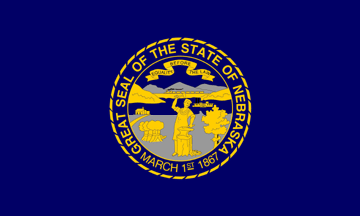
Nebraska Flag
|
The State of Nebraska Flag 1963
The Nebraska Territory would become the 37th state admitted to the Union on March 1, 1867. The Nebraska Territory (1854-1867) was created by the Kansas-Nebraska Act of 1854 and when the final extent of the territory was admitted to the Union as the State of Nebraska the territory ceased to exist.
Nebraska was one of the last states to adopt an official flag. In 1921, a state flag design by a New York Architect was presented to the Legislature, but was turned down as being inappropriate. The design finally accepted for the flag of the State of Nebraska was suggested by State Representative J. Loyed McMaster, who introduced a bill in 1925, designating a design which was adopted in 1925. His bill called for "a reproduction of the Great Seal of the State charged on the center in gold and silver on a field of national blue." The official designation of the design as the state flag occurred in 1963. |

Nevada Flag
|
The State of Nevada Flag 1991
Nevada became the 36th state to be admitted to the union on October 31, 1864. Previously known as the Nevada Territory (1861-1864) during the Civil War, part of Arizona Territory (1863-1912) and New Mexico Territory (1850-1912) were added to become the State of Nevada in 1864, just in time to help Abraham Lincoln get a few more sure votes in the Electoral College to be re-elected.
The current flag of Nevada was the winner of a design contest announced in 1926. The winning design was submitted by Louis Shellback III, but was slightly revised in the state legislature who argued over where to place the word "Nevada" on the flag. A compromise was reached, and in 1929, Governor Fred Balzar signed into law a bill adopting the new flag. A later law enacted in 1991 directed that the word "Nevada" appear below the star and above the sagebrush sprays, thus producing the current design.
The flag of the State of Nevada now consists of a cobalt blue field with a silver star in the upper left hand corner, surrounded by the state name "Nevada." Above this is a golden-yellow scroll with the words "Battle Born," (the state motto) indicating that Nevada became a state during the American Civil War. Below the star are two sprays of green sagebrush (the state flower) with yellow flowers. |
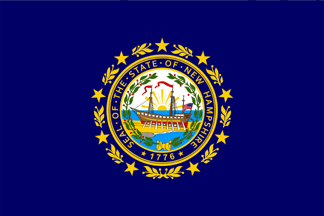
New Hampshire Flag
|
The State of New Hampshire Flag 1931
New Hampshire become the 9th state to join the Union on June 21, 1788. Originally the British Province of New Hampshire, it became one of the original 13 sovereign states under the Confederation (Articles of Confederation 1781-1789), and it was the 9th state to ratify the new United States Constitution in 1788 which guaranteed the necessary 2/3 vote for passage and made it the new law of the land.
Prior to 1909, the State of New Hampshire had no official state but was represented by various regimental flags. In 1909, the State legislature adopted a flag that consisted of the state seal centered on a blue background. The seal depicts the frigate USS Raleigh and is surrounded by a laurel wreath with nine stars. The Raleigh is one of the first 13 warships sponsored by the Continental Congress for a new American navy, built in 1776, at Portsmouth. Vexillologist James Ferrigan noted: "It is interesting that the Hew Hampshire state flag is the only state flag that depicts another state on its flag. The illustration of the seal is of the frigate Raleigh under construction on a sand bar which at the time the seal was made was part of Massachusetts, and is now part of Maine." The flag has only been changed once, in 1931 the state seal was modified.
|

New Jersey Flag
|
The State of New Jersey Flag 1896
New Jersey was the third state to join the new United States on December 18, 1787. Originally the British Province of New Jersey, it became one of the original 13 sovereign states under the Confederation (Articles of Confederation 1781-1789), and it was the 3rd state to ratify the new United States Constitution in 1788.
On March 11, 1896, Charles F. Hopkins of Morris County, on leave, introduced Assembly Joint Resolution No. 2 to define the New Jersey State Flag. According to the minutes of the New Jersey General Assembly they officially approved a flag with the state emblem centered on a the buff color field. This is due indirectly to George Washington, who had ordered on October 2, 1779, that the uniform coats of the New Jersey Continental Line be dark (Jersey) blue, with buff facings. Buff-colored facings had until then been reserved only for his own uniform and those of other Continental generals and their aides. Then, on February 28, 1780, the Continental War Officers in Philadelphia directed that the uniform coat facings of all regiments were to be the same as the background color of the regiments' state flag. Because of this, the flag they approved to be the State of New Jersey flag included the emblem from the Great Seal of the State of New Jersey on a buff-colored background. |
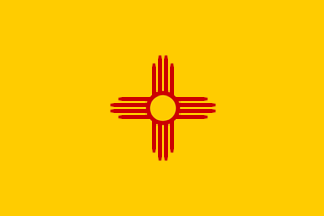
New Mexico Flag
|
The State of New Mexico Flag 1925
New Mexico, known as the New Mexico Territory (1850-1912), became the 47th state to be admitted to the Union on January 6, 1912. The original New Mexico Territory included most of the future Arizona, a small part of Colorado and Nevada. In 1863, during the American Civil War, Congress had divided the New Mexico Territory and created the new Arizona Territory abolished slavery in the new territory. The establishment of Colorado Territory in 1861 and of Arizona Territory in 1863 left New Mexico with its present boundaries.
In 1920, the Daughters of the American Revolution held a contest to design a contemporary and unique flag for New Mexico. The winner was Harry Mera of Santa Fe. Doctor Mera was an archaeologist who was familiar with the Zia sun symbol that has sacred meaning which symbolizes the Circle of Life: four winds, four seasons, four directions, and four sacred obligations. His winning design consisted of a red sun symbol of the Zia on a field of yellow. The colors honor Isabella I of Castile, her Habsburg heirs and the Conquistadors who explored in her name. |
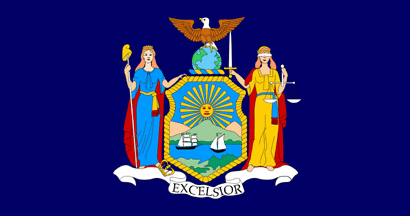
New York Flag
|
The State of New York Flag 1901
New York became the 11th state to vote to join the new United States on July 26, 1788. Originally the British Province of New York, it became one of the original 13 sovereign states under the Confederation (Articles of Confederation 1781-1789), and it was the 11th state to ratify the new United States Constitution in 1788.
The coat-of-arms used on the New York State Flag was adopted in 1778 and the present flag is a modern version of a Revolutionary War flag. The New York legislature changed the original design of the Revoluntary Flags field from buff to blue by a law enacted on April 2, 1901. The original with the buff field is part of the collection of the Albany Institute of History and Art.
Centered on the flag are Liberty on the left, with the Revolutionary imagery of a Phrygian cap raised on a pole. Her left foot treads upon a crown of the British monarchy and the left stands a blindfolded Justice, with scales and sword. The crest in the center shows the Hudson River landscape shows two ships represent inland and foreign commerce, both of which are important for the state of New York. On top of the crest is an eagle surmounting a world globe. The motto Excelsior is commonly translated as "Ever Upward." |
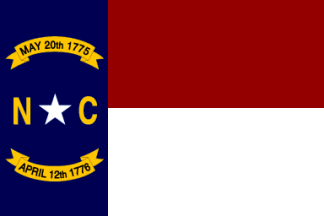
North Carolina Flag
|
The State of North Carolina Flag 1885
North Carolina would become the 12th state to join the new United States on November 21, 1789. Originally one of the British Provinces, North Carolina later became one of the original 13 sovereign states under the Confederation (Articles of Confederation 1781-1789), and it was the 13th state to ratify the new United States Constitution in 1788.
The present state flag of North Carolina is based on the flag of North Carolina that state Adjutant General, Johnstone Jones, a former Confederate soldier, introduced the bill which led the state legislature to adopt a new flag in March of 1885. The only real changes have been perportional (ratio) in nature. The flag has a blue union, containing a centered white star with a gold letter "N" on the left and the gold letter "C" on the right. Above the star is a semi-circular scroll containing in black letters "May 20th, 1775" (Mecklenburg Declaration of Independence) and below the star there is a similar scroll containing in black letters the inscription "April 12th, 1776" (Halifax Resolves). The fly of the flag has two equally proportioned bars, red (top) and white (bottom). |
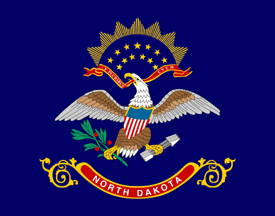
North Dakota Flag
|
The State of North Dakota Flag 1911
North Dakota became the 39th state and was admitted to the Union on November 2, 1889, the same day that South Dakota also became a state. The two new states had been previously part of the Dakota Territory (1861-1889), named after the Dakota branch of the Sioux tribes. The Dakota Territory consisted of the northernmost part of the land acquired in the Louisiana Purchase of the United States. The Dakota Territory had been formerly part of the Minnesota and Nebraska territories.
The design for the flag of the State of North Dakota is an almost exact copy of the unit banner carried by the state's troop contingent in the Philippine-American War. It was adopted by the North Dakota Legislative Assembly in 1911. The original troop banner is on display at the North Dakota Heritage Center in Bismarck. |
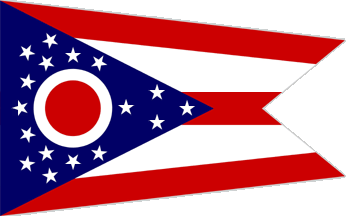
Ohio Flag
|
The State of Ohio Flag 1902
Ohio, originally part of the old Northwest Territory, became the 17th state to be admitted to the Union on March 1, 1803. The Northwest Territory (1787-1803) consisted of land donated to the Federal Government by the Eastern Coast states of Pennsylvania, Virginia, Connecticut, and New York, and was located in the Ohio River Valley. The Territory actually pre-dated the United States, because the Congress of the Confederation enacted the Northwest Ordinance in 1787 to provide for the administration of the territories and set rules for admission as a state.
The flag of the State of Ohio was adopted in 1902 and designed by John Eisemann, for the 1901 Pan-American Exposition. It differs from all other United States state flags in its shape. Loosely based upon the design of cavalry guidons of the Civil War and Spanish-American War, the proper name for this type of flag is burgee (broad tapering pennant, often with a swallowtail). It consists of 5 horizontal stripes alternating between red and white. The chevron is azure blue and contains a white and red "O" and 17 white stars.
|
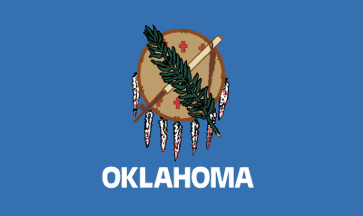
Oklahoma Flag
|
The State of Oklahoma Flag 2006
The 46th state to be admitted to the Union was Oklahoma on November 16, 1907. The new state had been located in the Oklahoma Territory (1890-1907) and the Indian Territory (1834-1907), which had originally been set aside within the United States for the re-settlement of American Indians. The Indian Territory formed to provide a place to send Native American tribes after the passage of the Indian Removal Act of 1830, championed by President Andrew Jackson. In 1905, the citizens of Indian Territory tried to gain admission to the union as the State of Sequoyah, but two years later, in 1907, Oklahoma Territory was joined with the Indian Territory by Congress and admitted to the Union as the State of Oklahoma.
The flag of the State of Oklahoma consists of a traditional Osage Nation buffalo-skin shield with seven eagle feathers on a sky blue field. In a flag contest sponsored by the Daughters of the American Revolution in 1924, the winning entry was by Louise Fluke. On April 2, 1925, her design was adopted as the state flag, but without the word "Oklahoma" on it, which was added in 2006. |
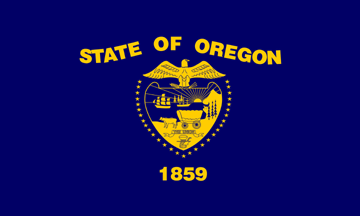
Oregon Flag (obverse)
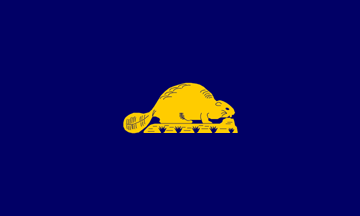
Oregon Flag (reverse)
|
The State of Oregon Flag 1925
On February 14, 1859, the southwestern portion of the Oregon Territory officially became the 33rd state to be admitted to the Union as Oregon. Originally, the Oregon Territory (1848-1859) was formed when the region known as the Oregon Country was divided by treaty between the U.S. and Great Britain in 1846, and included the current states of Oregon, Washington, and Idaho, as well as parts of Wyoming and Montana.
The flag of the State of Oregon is a two-sided flag in navy blue and gold lettering with an optional gold fringe. On the front is the escutcheon from the state seal and on the reverse is a gold figure of a beaver (the state animal). Oregon is the only U.S. state to have a two-sided flag.
The seal of the State of Oregon is an escutcheon, outlined by 33 stars and an inscription, "The Union." On the top of the crest are shown mountains, an elk with branching antlers, a wagon, the Pacific Ocean, on which there are a British man-of-war departing and an American steamer arriving. On the bottom is shown a sheaf, a plow and a pickax. On top of the crest is the American eagle and written above the eagle are the words "State of Oregon, 1859."
The current flag design became official on February 26, 1925. The first flag of Oregon produced was made by Marjorie Kennedy and Blanche Cox. It is housed at Eastern Oregon University. |
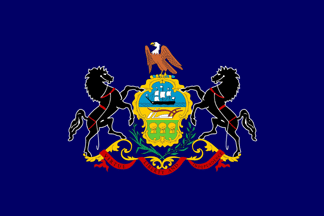
Pennsylvania Flag
|
The Commonwealth of Pennsylvania Flag 1907
Pennsylvania was the second state, or Commonwealth, to join the United States on December 12, 1787. Originally the British Province of Pennsylvania, it became one of the original 13 sovereign states under the Confederation (Articles of Confederation 1781-1789), and it was the 2nd state to ratify the new United States Constitution in 1788. It is also one of the four states to retain the old English name of Commonwealth.
The first Pennsylvania State flag was adopted by the Executive Council in 1778. It was used to identify the State's wharf in Philadelphia, but the background color is not stated. One theory is that it may have been red, because red was used as background in the majority of surviving PA revolutionary colors. The current flag was adopted in 1907, and is composed of a blue field on which is embroidered with the State Coat-of-Arms. The use of the blue field dates back to the Civil War when many Pennsylvania regiments carried flags modeled after the canton of the U.S. Flag, but substituted Pennsylvania's Coat-of-Arms for the field of stars.
|

Rhode Island Flag
|
The State of Rhode Island Flag 1897
When Rhode Island became the 13th state to join the Union on May 29, 1790, it completed the process of joining together the original 13 states of the United States of America. Originally one of the British Provinces, it was also one of the original 13 sovereign states under the Confederation (Articles of Confederation 1781-1789), and it was the last state to ratify the new United States Constitution in 1788.
The present flag of the State of Rhode Island was formally adopted by the Rhode Island General Assembly in 1897, replacing a similar flag, but with a blue background, that had used during the Confederation years (1882-1897). Rhode Island was the third of the original thirteen colonies to formally adopt a state flag, New Jersey and New York having done so in 1896. The colors, white and blue, are the same as those used in the flags carried by the regiments of Rhode Island during the American Revolution and the War of 1812. The anchor has been connected with Rhode Island since its foundation. As early as the 1640s, the word "hope" was found on the Rhode Island Seal. Most experts believe the word was inspired by the biblical phrase of "Hope, we have as an anchor of the soul." |
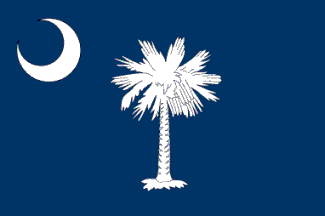
South Carolina Flag
|
The State of South Carolina Flag 1861
The Province of South Carolina became the 8th state to join the Union on May 23, 1788. Originally the British Province of South Carolina, it became one of the original 13 sovereign states under the Confederation (Articles of Confederation 1781-1789), and it was the 8th state to ratify the new United States Constitution in 1788.
The flag of the State of South Carolina dates back to 1765 when opponents of the Stamp Act marched in protest behind a blue flag bearing three white crescents. In 1775, Colonel William Moultrie was asked by the Revolutionary Council of Safety to design a flag for the South Carolina troops to use during the American Revolutionary War. Moultrie's design had the blue of the militia's uniforms and the crescent from the emblem on their caps. The palmetto tree was officially added in 1861 to honor Moultrie's heroic defense of the palmetto log fort on Sullivan's Island against the attack of the British fleet on June 28, 1776, but the South Carolina Militia Act of 1839 specified flags with palmetto trees on them, with either red fields or blue fields, could be used on Militia flags and the Palmetto Regiment of the Mexican War carried flags of this nature in the mid-1840's. |
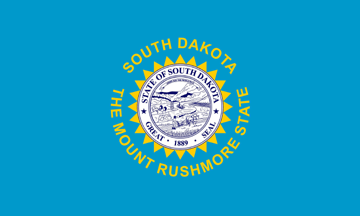
South Dakota Flag
|
The State of South Dakota Flag 1992
South Dakota became the 40th state and admitted to the Union on November 2, 1889, the same day that North Dakota also became a state. The two new states had been previously part of the Dakota Territory (1861-1889), named after the Dakota branch of the Sioux tribes. The Dakota Territory consisted of the northernmost part of the land acquired in the Louisiana Purchase of the United States. The Dakota Territory was formerly part of the Minnesota and Nebraska territories.
The flag of the State of South Dakota has a field of sky blue and the state seal in the center, surrounded by gold triangles representing the sun's rays. The inscription in gold sans-serif capitals of "SOUTH DAKOTA" arches over the top and "THE MOUNT RUSHMORE STATE" (the state nickname) revese arches on the bottom. An inscription on the bottom "THE SUNSHINE STATE" was removed in 1992. |
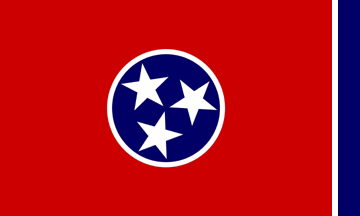
Tennessee Flag
|
The State of Tennessee Flag 1905
Tennessee became the 16th state to be admitted to the Union on June 1, 1796. Many Carolinian frontiersmen had moved west over the mountains into the Washington District (later known as Tennessee), but in 1789 the state relinquished its claim to the western lands, ceding them to the national government. Tennessee was formed from the western lands donated to the Federal Government by North Carolina.
The Tennessee State Flag was designed by Captain LeRoy Reeves of the Third Regiment, Tennessee National Guard. The three stars represent the three main geographical divisions of the state, East Tennessee, Middle Tennessee, and West Tennessee. The blue circle around the stars represents the unity of the of the state. The blue bar at the edge of the flag was purely a design consideration and prevents the flag from showing too much crimson when hanging limp. This flag was adopted as the official flag of the State of Tennessee by an act of the Tennessee Legislature and approved April 17, 1905.
|

Texas Flag
|
Republic of Texas 1839-1845, State of Texas Flag 1845
Texas was the 28th state to be admitted in to the Union on December 29, 1845. What makes Texas unusual was that prior to admittance to the United States it was an independent nation called the Republic of Texas (1836-1845) after successfully rebelling against Mexico in the Texas War of Independence (1835-1836). It is one of seventeen U.S. states (along with Vermont, Hawaii, California, and each of the original Thirteen Colonies) that each once had a sovereign government.
The Texas flag is known as the "Lone Star Flag" and was introduced to the Congress of the Republic of Texas on December 28, 1838, by Senator William H. Wharton. It was adopted on January 25, 1839 as the national flag of the Republic of Texas. In 1845 when Texas was admitted to the Union, they kept the same flag as their Texas State Flag.
To learn more visit the Flags of Texas Independence
page.
|
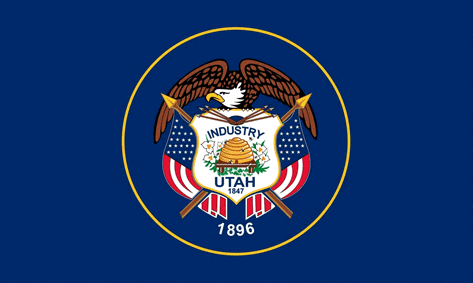
Utah Flag
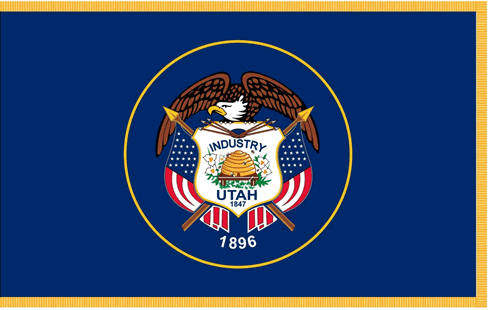
Utah Ceremonial Flag
|
The State of Utah Flag 1913
Utah Territory became the 45th state to be admitted to the Union on January 4, 1896. The creation of the Utah Territory was championed by the Mormons, who under the leadership of Brigham Young, had settled in the valley of the Great Salt Lake starting in 1847. The Mormons had also petitioned Congress for entry into the Union as the State of Deseret, but the Utah Territory (1850-1896) was created instead by an act of Congress in 1850, on the same day that the State of California was admitted to the Union. The territory was created as part of the Compromise of 1850 that it was hoped would preserve the balance of power between slave and free states. Morman Utah became a free state.
The flag of the State of Utah was adopted in 1913 and consists of the seal of Utah encircled in a golden circle on a background of navy blue. The Great Seal consists of a thin gold circle, which encloses the coat-of-arms. The coat-of-arms contains a beehive which has the state motto "INDUSTRY" arced above and the word "UTAH" and "1847," the year of Mormon settlement, below, and is flanked by sego lilies, the state flower. Six arrows originate from above "INDUSTRY" and go out past the border of the shield. An eagle is perched on top of the shield, ready to take flight. The shield is flanked by United States flags on both sides, their poles crossed behind the shield, and immediately below the shield is "1896," the year of statehood.
To learn more visit the Historical Flags of the State of Utah. |
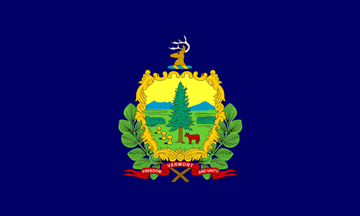
Vermont Flag
|
The State of Vermont Flag 1923
Vermont became the 14th state to be admitted to the Union on March 4, 1791. Originally part of the huge Province of New York (1664-1775), Vermont became one of seventeen U.S. states (along with Texas, Hawaii, the brief California Republic, and each of the original Thirteen Colonies) that were once sovereign countries. As part of a power struggle between New York and New Hampshire, some settlers held land grants for the same land, known as the New Hampshire Grants. The land claims were opposed by the Green Mountain Boys militia, which eventually succeeded in creating an independent state, the Vermont Republic (1777-1791) during the early years of the American Revolution.
The flag of the State of Vermont consists of the state's coat-of-arms and motto on a field of azure blue. The Vermont General Assembly adopted the current flag in 1923, because of confusion between an earlier striped Vermont state flag and the U.S. flag. Actually, the new design was the same used as the Vermont Governor’s flag. While the pine needle supporters of the coat-of-arms are representive all of New England, the pine tree in the middle of the coat-of-arms represents the Vermont forests. The cow and three sheaves of wheat represent the dairy and agriculture industries. The deer head on top represents Vermont's wildlife. The Green Mountains are in the background as well. The motto, "Freedom and Unity", is also used. The motto balances two different ideals, the freedom of the individual citizen, and the welfare of the common good. |
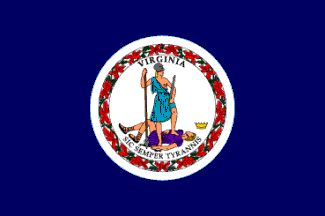
Virginia Flag
|
The Commonwealth of Virginia Flag 1861
Virginia was the 10th state of the United States of America joining on June 25, 1788. Originally the British Province of Virginia, it became one of the original 13 sovereign states under the Confederation (Articles of Confederation 1781-1789), and it was the 10th state to ratify the new United States Constitution in 1788. It is also one of the four states to retain the old English name of Commonwealth.
The flag of the Commonwealth of Virginia consists of the seal of Virginia against a blue background. The current version of the flag was adopted at the beginning of the American Civil War in 1861. The flag may be decorated with a white fringe along the fly. However, the Virginia state flag adopted in 1861 is a bit different than the flag adopted afterwards that flies today. The two changes are the laurel wreath that goes around the state coat-of-arms (a post-Civil War addition), as was the bared breast of the lady liberty figure in the coat-of-arms. During the Civil War era she was completely covered up. The Latin motto "Sic semper tyrannis" at the bottom of the state seal means "Thus Always to Tyrants." This quote is attributed to Brutus during the assassination of Julius Caesar in Rome. The woman is "Virtus, the genius of the Commonwealth, dressed as an Amazon" and represents Virginia. The prostrate man represents tyranny; note the fallen crown to the right. The tyrant is holding both a chain and a scourge. |
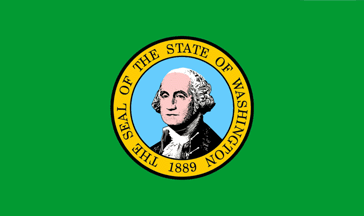
Washington Flag
|
The State of Washington Flag 1925
Washington was the 42nd state to be admitted to the Union on November 11, 1889. Known as the Washington Territory between 1853 and 1889, it was created from the portion of the Oregon Territory north of the Columbia River and north of the 46th parallel that had been ceded by Britain to the United States in the Treaty of 1846 settlement of the Oregon Boundary Dispute. This treaty established what became the longest undefended border in the world.
The flag of the State of Washington consists of the Washington State Seal which bears an image of George Washington on a field of dark green. A gold fringe is optional. It is the only U.S. state flag with a field of green, as well as the only state flag with the image of an American president. The design was adopted in 1923, prior to which Washington had no official state flag. |
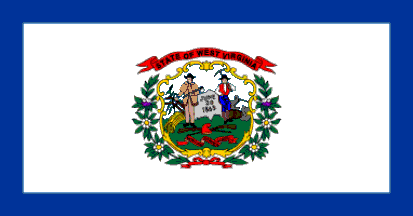
West Virginia Flag
|
The State of West Virginia Flag 1863
West Virginia became the 35th state to be admitted to the Union on June 20, 1863. The settlers of the area refused to join the rest of Virginia at the outbreak of the Civil War (1861-1865) and voted to stay with the North, so they divided off from Virginia and where made a separate state in 1863. This made West Virginia was the only state in the Union to secede from the Confederate States of America during the Civil War.
The flag of the State of West Virginia consists of the state's coat-of-arms on a white field with a dark blue border, adopted in 1929. After West Virginia broke away from Virginia in the midst of the Civil War and was admitted to the Union as a separate state in 1863, a committee of the West Virginia State Legislature commissioned Joseph H. Diss Debar, a local artist and political figure, to design a state seal. Debar's design was approved by the legislature on 26 September 1863. The West Virginia coat-of-arms is featured in the flag's center. The coat-of-arms symbolizes the state's principal pursuits and resources. The obverse side of the seal bears the legend "State of West Virginia" together with the state motto Montani Semper Liberi (mountaineers are always free). A farmer stands to the left and miner to the right of a large ivy draped rock bearing the date of the state's admission to the Union, June 20, 1863. The lower half of the coat-of-arms is wreathed by the rhododendron, the state flower.
|
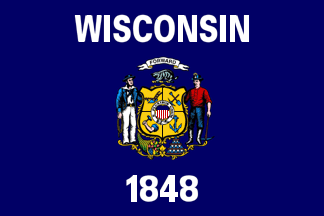
Wisconsin Flag
|
The State of Wisconsin Flag 1979
The Wisconsin Territory became the State of Wisconsin and the 30th state admitted to the Union on May 29, 1848. The Wisconsin Territory (1836-1848), formed from the old Northwest Territory (1787-1803), was first part of the Indiana Territory (1800-1816), then part of the Illinois Territory (1809-1818), and when Illinois was about to become a state in 1818, they were moved to the Michigan Territory (1805-1837). In 1836, they were split off from Michigan Territory as the state of Michigan prepared for statehood. As the last man standing, they became their own Territory in 1836.
The flag of the State of Wisconsin is a blue flag charged with the state coat-of-arms. Originally designed in 1863 when regiments from Wisconsin wanted a flag for battlefield use, it wasn't until 1913 that state statutes specified the design of the state flag. In order to distinguish it from the many other blue U.S. state flags, Wisconsin's flag was modified in 1979 to add "Wisconsin" and "1848," the year Wisconsin was admitted to the Union |
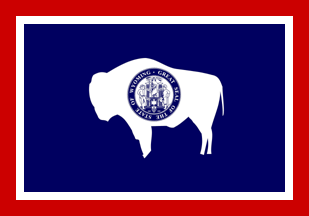
Wyoming Flag
|
The State of Wyoming Flag 1917
The Wyoming Territory was admitted to the Union as the 44th state on July 10, 1890. The Wyoming Territory (1868-1890) had identical boundaries to that of the modern State of Wyoming. Because of Wyoming's location it had been claimed by Great Britain, France, Spain, Mexico, and Texas, and later fell under the jurisdiction of the Washington Territory, the Oregon Territory, the Idaho Territory, the Dakota Territory, the Nebraska Territory and the Utah Territory prior to becoming it's own Wyoming Territory in 1868.
The flag of the State of Wyoming was designed by 23-year old Veran Keays in 19i6 as an entry to a contest sponsored by the Wyoming Daughters of the American Revolution. Verna Keays won $20.00 for her efforts and competed against 36 other entries. She was 24 years old when her design was officially designated the state flag a year later. Basically her design consisted of the silhouette of an American Bison. The red symbolizes the Native Americans and the blood of pioneers who gave their lives. The white is a symbol of purity and uprightness. The blue is the color of the skies and distant mountains. The bison represents the local fauna while the seal on it symbolizes the custom of branding livestock.
|
Much of the text on this page was used, sometimes modified, from text on the "Flags of the World" and from "Wikipedia."
|